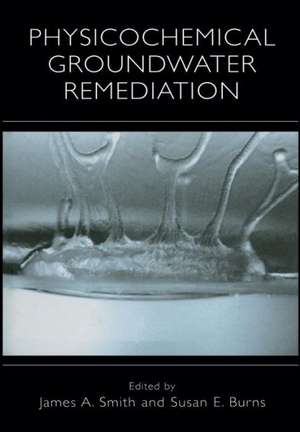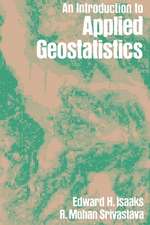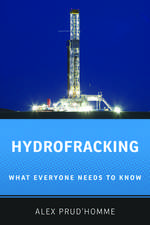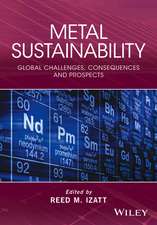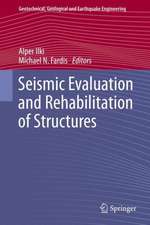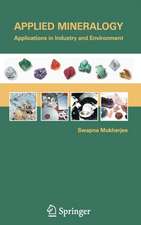Physicochemical Groundwater Remediation
Editat de James A. Smith, Susan E. Burnsen Limba Engleză Paperback – 24 mar 2013
Physicochemical Groundwater Remediation presents detailed information on multiple emerging technologies for the remediation of the contaminated subsurface environment. All of these technologies apply our knowledge of physical and chemical processes to clean up ground water and the unsaturated zone, and many (if not all) of these emerging technologies will help define standard practices in the future. These technologies include in situ sorptive and reactive treatment walls, surfactant-enhanced aquifer remediation, optimization analyses for remediation system design, chemical, electrochemical, and biochemical remediation processes, and monitored natural attenuation. You will learn how palladium catalyzes the dehalogenation of chlorinated solvents. You will find out how barometric pumping can naturally remove significant quantities of volatile organic pollutants from shallow ground water and the unsaturated zone. You can learn about mobilizing non-aqueous phase liquids (NAPLs) without risking significant downward migration of the NAPL. You can find out how processes such as electroosmosis and electromigration can be exploited for groundwater remediation purposes and how zero-valent iron and zeolite treatment walls can be used in situ to treat and control contaminant plume migration. Contributors to this book are experts in groundwater remediation processes, and they represent industry, consulting, academia, and government.
If your work involves the clean up of contaminated soil and groundwater, this book is an essential reference to keep you up to date on the most promising new developments in remediation research.
| Toate formatele și edițiile | Preț | Express |
|---|---|---|
| Paperback (1) | 647.27 lei 6-8 săpt. | |
| Springer Us – 24 mar 2013 | 647.27 lei 6-8 săpt. | |
| Hardback (1) | 657.25 lei 6-8 săpt. | |
| Springer Us – 31 iul 2001 | 657.25 lei 6-8 săpt. |
Preț: 647.27 lei
Preț vechi: 761.49 lei
-15% Nou
Puncte Express: 971
Preț estimativ în valută:
123.85€ • 129.32$ • 102.27£
123.85€ • 129.32$ • 102.27£
Carte tipărită la comandă
Livrare economică 15-29 aprilie
Preluare comenzi: 021 569.72.76
Specificații
ISBN-13: 9781475787665
ISBN-10: 1475787669
Pagini: 384
Ilustrații: XII, 366 p.
Dimensiuni: 170 x 244 x 20 mm
Greutate: 0.61 kg
Ediția:2002
Editura: Springer Us
Colecția Springer
Locul publicării:New York, NY, United States
ISBN-10: 1475787669
Pagini: 384
Ilustrații: XII, 366 p.
Dimensiuni: 170 x 244 x 20 mm
Greutate: 0.61 kg
Ediția:2002
Editura: Springer Us
Colecția Springer
Locul publicării:New York, NY, United States
Public țintă
ResearchCuprins
Dynamic Optimal Design of Groundwater Remediation Using Genetic Algorithms.- Optimal Plume Capture Design in Unconfined Aquifers.- Palladium Catalysis for the Treatment of Contaminated Waters: A Review.- Electrochemical and Biogeochemical Interactions under dc Electric Fields.- Transport of Trichloroethylene (TCE) in Natural Soil by Electroosmosis.- Sorbing Vertical Barriers.- Reductive Dechlorination of Chlorinated Solvents on Zerovalent Iron Surfaces.- Pilot Test of a Surfactant-modified Zeolite Permeable Barrier for Groundwater Remediation.- Effects of Surfactant Sorption on the Equilibrium Distribution of Organic Pollutants in Contaminated Subsurface Environments.- Surfactant-enhanced Desorption of Organic Pollutants from Natural Soil.- Surfactant-enhanced Removal of Hydrophobic Oils from Source Zones.- In Situ Density Modification of Entrapped Dense Nonaqueous-phase Liquids (DNAPLs) Using Surfactant/Alcohol Solutions.- Effects of Cosolvent Addition on Surfactant Enhanced Recovery of Tetrachloroethene (PCE) from a Heterogeneous Porous Medium.- Unsaturated-zone Airflow: Implications for Natural Remediation of Groundwater by Contaminant Transport through the Subsurface.- High-vacuum Soil Vapor Extraction in a Silty-clay Vadose Zone.
